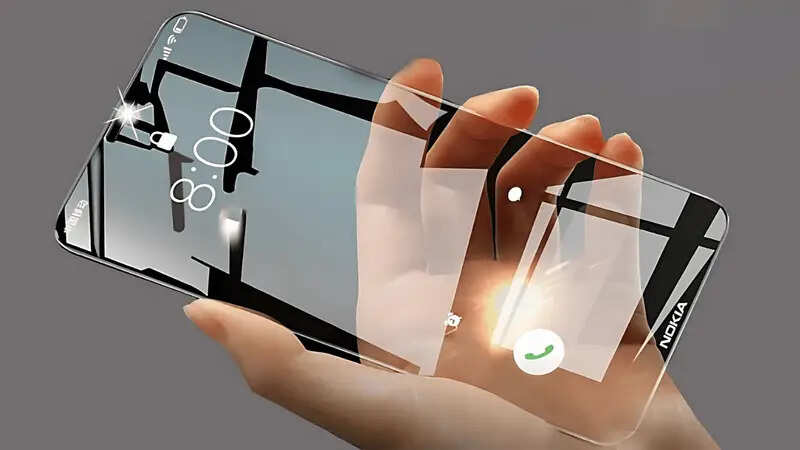Nokia Prism first fully functional transparent smartphone with stunning technological

Nokia Prism: In a stunning technological breakthrough that has captured global attention, Nokia has officially unveiled the world's first fully functional transparent smartphone. Dubbed the Nokia Prism, this revolutionary device represents the culmination of over five years of intensive research and development in transparent electronics, flexible display technology, and miniaturized component design. Launched at a spectacular event in Helsinki on June 10, 2025, the Prism has instantly redefined what consumers thought possible in mobile technology.
Transparency Reimagined: Engineering the Impossible
The Nokia Prism achieves its transparency through a sophisticated combination of transparent circuit boards, invisible wire mesh conductors, and Nokia's proprietary "ClearSight" display technology. The 6.7-inch screen utilizes advanced microLED technology with transparent substrates, achieving an impressive 85% transparency when displaying content and nearly 95% when in standby mode.
Unlike previous attempts at transparent phones that merely featured small transparent sections or relied on clever camera implementations to create an illusion of transparency, the Prism is genuinely see-through from front to back. Only a small opaque section at the bottom houses the most challenging components to miniaturize, including the primary processing unit and battery management system.
Nokia's engineering team solved the considerable power challenge by incorporating transparent graphene-enhanced lithium-ion batteries distributed throughout the phone's frame. This distributed power system not only enables the transparent design but also improves heat dissipation and structural integrity.
Adaptive Transparency: Practical Innovation
Recognizing that complete transparency isn't always desirable, Nokia has implemented an electrochromic layer that allows users to adjust the device's opacity. This "SmartOpacity" feature enables the Prism to transition from nearly crystal clear to a frosted finish or even completely opaque, addressing privacy concerns and improving screen visibility in bright conditions.
The opacity can be adjusted manually via gestures or automatically based on environmental conditions and user activity. For example, the phone will automatically increase opacity when displaying sensitive information like banking apps or private messages, and return to transparency when using navigation or camera functions.
This adaptive transparency extends to individual areas of the display, allowing for mixed modes where portions remain clear while others display content with higher contrast. During demonstrations, Nokia showed how navigation directions could overlay the real world while simultaneously displaying messaging apps in more opaque sections.
Holographic Interface: Beyond Two Dimensions
Perhaps the most captivating feature of the Prism is its revolutionary holographic user interface. By leveraging the transparent display and an array of micro-projectors embedded in the phone's frame, the Prism can generate floating holographic elements that appear to hover above the device.
This "HoloUI" system enables three-dimensional interactions with notifications, media controls, and specialized applications. Users can manipulate these holographic elements through mid-air gestures captured by time-of-flight sensors integrated into the phone's bezel. The effect is both futuristic and intuitive, allowing for interaction without obscuring the transparent display.
The holographic capabilities shine particularly in specialized applications. During the demonstration, Nokia showcased a design app where 3D models could be manipulated in space above the phone, an interactive planetarium that projected constellations that responded to movement, and gaming experiences where characters appeared to leap from the screen.
Invisible Components, Visible Performance
Despite its revolutionary design, Nokia hasn't compromised on performance. The Prism houses a custom-designed neural processing unit optimized for transparent electronics, delivering performance comparable to conventional flagship devices while consuming significantly less power.
The camera system represents another engineering triumph. Instead of traditional opaque camera modules, Nokia developed a distributed imaging system with multiple transparent lenses working in concert. This "MultiOptics" array captures information from different perspectives simultaneously, using computational photography to create 108MP-equivalent images with impressive depth information and low-light performance.
The transparent design enables some unique photographic capabilities, such as capturing both sides of a scene simultaneously or taking selfies using the main camera array while seeing through the phone to perfectly frame the shot.
Sustainable Vision: Environmental Considerations
Nokia has emphasized the sustainable aspects of the Prism's design and manufacturing. The transparent components utilize bio-sourced polymers derived from sustainable materials, while the distributed battery system eliminates the need for cobalt, addressing ethical concerns in battery production.
The phone's modular construction allows for individual components to be replaced rather than disposing of the entire device, significantly extending its useful life. All components are designed for easy disassembly and recycling at end-of-life, with Nokia establishing a dedicated recycling program for transparent electronics.
Contextual Computing: Environmental Awareness
The Prism introduces Nokia's "ContextOS," an operating system designed specifically for transparent devices. This platform leverages the phone's unique capabilities to deliver genuinely contextual computing experiences that blend digital information with the physical world.
The system uses computer vision algorithms to recognize objects viewed through the transparent display and provide relevant information or functionality. Point the phone at a landmark, and historical information appears alongside it. View a product in a store, and pricing comparisons float beside it. Look at a restaurant, and reviews and menu highlights appear without obstructing your view.
This contextual awareness extends to social situations as well. The phone can recognize saved contacts in its field of view and display relevant information like recent messages or upcoming shared events. Privacy settings allow users to control exactly what information is visible and under what circumstances.
Market Position and Availability
The Nokia Prism will initially launch in limited quantities, with full production ramping up throughout the second half of 2025. With a starting price of €1,499, it positions itself firmly in the ultra-premium segment, though Nokia executives have indicated that the technology will eventually cascade to more affordable models as manufacturing processes mature.
Initial markets include the EU, UK, Japan, South Korea, and Singapore, with North American availability planned for September 2025. Nokia has partnered with select luxury retailers to showcase the device in specialized display environments that highlight its transparent design.
Conclusion: A Clear Vision of the Future
With the Prism, Nokia has accomplished what many thought impossible: creating a genuinely transparent smartphone that's not only functional but offers unique capabilities impossible on conventional devices. The breakthrough represents a potential inflection point in mobile technology, similar to the introduction of the touchscreen or the smartphone itself.
While questions remain about mass-market adoption and practical everyday use cases, the Prism demonstrates Nokia's commitment to pushing the boundaries of mobile technology. After years of operating in the shadow of other manufacturers, this bold innovation positions Nokia once again at the forefront of mobile innovation.
Whether the transparent smartphone becomes the next must-have device or remains a fascinating technological curiosity, the Nokia Prism unquestionably represents one of the most significant hardware innovations in recent memory. It offers a literal and figurative window into how we might interact with technology in an increasingly blended physical and digital world.
As we move toward more immersive computing experiences through augmented reality and environmental computing, the Prism suggests that the future of technology might not be about adding more screens to our lives, but about making those screens disappear altogether.
